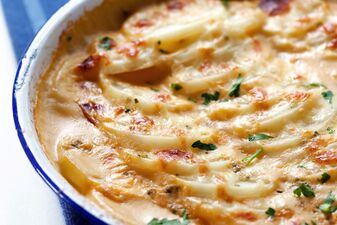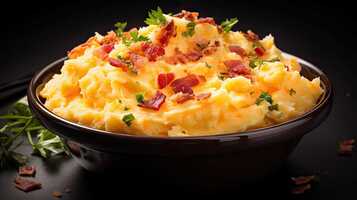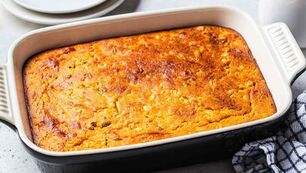…from the Perspectives’ Kitchen How you doin’? Perspectives developed SPOT, a Lebanese-style restaurant, for our Azerbaijan clients; it opened in Berlin, Germany. Got all that? Being that we didn’t feel all that safe in Beirut, we spent a couple of weeks in London where all the best Lebanese chefs immigrated to escape the Middle East turmoil. One of the dishes we came to love was Baba Ganoush for its bright, simple flavors and silky texture. After tasting the best that London had to offer, I updated this classic to appeal to European and American tastes. The word bābā in Arabic is a term of endearment for 'father', while Ġannūj could be a personal name. The word combination is also interpreted as 'father of coquetry' or 'indulged/pampered/flirtatious daddy' or 'spoiled old daddy'. However, it is not certain whether the word bābā refers to an actual person indulged by the dish or to the eggplant (bāḏinjān or bātinjān in Arabic). Very old dish… very old history. In my Baba Ganoush recipe, the eggplant is broiled until it is charred / blackened from end to end. After you scrape off all the char, the only thing left is the steamed lush, smoky flesh. I then purée with roasted garlic, lemon juice, tahini and cayenne. When served, I top it with a swirl of cumin-flavored olive oil, paprika, mint and fresh parsley. I like to serve Baba Ganoush at summertime picnics and outdoor barbecues. It is a rustic spread full of smoke, garlicky piquancy, lemon and vegetable sweetness of the eggplant which complements grilled lamb and chicken. It tastes amazing on a soft triangle of homemade pita bread. Pita bread is pretty easy to make for home cooks and can even be made on the gates of a hot barbecue. Prep time: 30 minutes Cook time: 10 to 15 minutes Yield: 2 Cups Ingredients 2 pounds eggplant 1/4 cup tahini (sesame) 1/4 cup freshly squeezed lemon juice 4 garlic cloves, mashed to a paste 1/8 teaspoon cayenne 1/2 teaspoon kosher salt 1/2 teaspoon cumin seed, toasted until fragrant and coarsely ground 3 tablespoons olive oil 1/2 teaspoon smoky paprika 1 tablespoon finely chopped parsley 1 tablespoon finely chopped mint Homemade pita or chips for serving Directions
ChefSecret: You can personalize my Baba Ganoush recipe and make it yours. If you like it salty, top it with olives. If you like a ton of herbs, pile it up with mint, parsley and basil. If you live for the smoky flavor, sprinkle with a little more smoky paprika. Quip of the Day: Did you know that a Lebanese fortune teller reads the future in the swirls of Baba Ganoush? ------------------------------------------- Do you have a question or comment? Send your thoughts to [email protected]. All recipes and cooking tips are posted on our website https://www.perspectives-la.com/covid-19-survival-guide. ------------------------------------------- To you and everyone dear to you, be strong, positive, stay well, stay safe and be kind. Take a breath and count your blessings, and if you have a little extra to share with others, please consider donating to Feeding America, Tunnel to Towers, Union Rescue Mission and/or American Red Cross. #Appetizer #Dip #SmokyBabaGanoush #BabaGanoush #LebaneseDips #2024Recipes #URM #T2T #FeedingAmerica #RedCross #PerspectivesTheConsultingGroup ©PERSPECTIVES/The Consulting Group, LLC, 2024
0 Comments
…from the Perspectives’ Kitchen How you doin’ pardner? I imagine that this is what Roy Rogers, Dale Evans and Hop-Along Cassidy might have feasted on in the 1950’s. So, move over, wimpy dips—this recipe for my Texas Grilled Corn Cowboy Caviar is hearty and party ready. This classic summer side is chock-full of sweet, smoky grilled corn, creamy beans, juicy tomatoes, and tangy onions. Every bite is a garden-fresh mélange of wonderful flavors and textures. This recipe makes enough for the entire bunk house full of cowboys, so you’ll definitely want to share it with friends. Make a big batch and bring it to your family or friend’s 4th of July barbecue this weekend—or invite your pals over for a happy hour campfire and keep the leftovers in your fridge for snacking on later. Prep time: 20 minutes Yield: 10 servings Ingredients 1/2 cup extra virgin olive oil 1/3 cup red wine vinegar 3 teaspoons minced garlic 1 teaspoon granulated sugar 1/2 teaspoon kosher salt 1/4 teaspoon freshly-ground black pepper 1/8 teaspoon ground cayenne pepper 4 ears of fresh corn (use fresh… it’s summer!) 1 tablespoon extra-virgin olive oil 1 15-ounce can rinsed black beans 1 15-ounce can rinsed black-eyed peas 3 diced tomatoes 1 diced red bell pepper 1 minced jalapeño pepper 1/2 cup diced red onion 1/2 cup chopped cilantro leaves with tender stems 1 thinly sliced green onion, tops and bottoms Directions
ChefSecret: You can serve this spaghetti-western style on rounds of grilled Italian bread bruschetta style. Quip of the Day: What style is it when someone who wears cowboy clothes? Ranch dressin’. This is as corny as my Texas Grilled Corn Cowboy Caviar. ------------------------------------------- Do you have a question or comment? Send your thoughts to [email protected]. All recipes and cooking tips are posted on our website https://www.perspectives-la.com/covid-19-survival-guide. ------------------------------------------- To you and everyone dear to you, be strong, positive, stay well, stay safe and be kind. Take a breath and count your blessings, and if you have a little extra to share with others, please consider donating to Feeding America, Tunnel to Towers, Union Rescue Mission and/or American Red Cross. #SideDish #Salad #GrilledSweetCorn #TexasCornCaviar #4thJulySalad #2024Recipes #URM #T2T #FeedingAmerica #RedCross #PerspectivesTheConsultingGroup ©PERSPECTIVES/The Consulting Group, LLC, 2024 … from the Perspectives’ Kitchen How you doin’? Potatoes are one of the most versatile and inexpensive vegetables. They can be baked, boiled, oven roasted or made au gratin or scalloped style. At Fanny’s Fish Market (one of my own restaurants) I was partial to Scalloped Potatoes. In traditional recipes, scalloped potatoes are made with Cheddar cheese, milk and a sprinkle of flour. They bake up super cheesy and comforting and I love them, but spring calls for something lighter. So here I’ve layered thin slices of potato with nutty-sweet Gruyère cheese (which is lighter than Cheddar), warm cream and mild springtime leeks that have been sautéed and softened in butter. The potatoes bake up golden brown, and they have a wonderful texture—crispy and creamy at the same time, with a perfectly al dente bite—not the least bit soggy or pasty.) The leeks are so unbelievably tender, they seem to melt into the potato. I like to scatter some bright green chives over the top of the casserole as it comes out of the oven, and I love how their delicate onion flavor balances the dish—it’s rich, savory, cheesy, and light in all the right proportions. In short, it tastes just like early spring. I used this as a great side for grilled or baked fish; the fresh cream and mild onions are the ideal foil for a piece of mild, grilled white fish. It is also great with a grilled steak of any cut and can easily be used as a side dish at brunch. Prep time: 20 minutes Bake time: 90 minutes Yield: 8 servings Ingredients 2 tablespoons unsalted butter, plus more for prepping the pan 3 cups chopped leeks (white and pale green parts only), soaked, rinsed and drained well 2 teaspoons kosher salt 1/2 teaspoon freshly ground black pepper 4 pounds baking potatoes, peeled and thinly sliced (I prefer Russets) 2 tablespoons chopped fresh chives, plus more for garnish 2 cups shredded Gruyère cheese 3 cups heavy whipping cream 1 teaspoon ground nutmeg Directions
ChefSecrets: You can change this recipe up a bit by substituting cauliflower florets for potatoes—Gruyère Scalloped Cauliflower with Spring Leeks. Yum! Quip of the Day: Q. What do you call a cauliflower growing at the edge of a garden? A. A border cauli! ------------------------------------------- Do you have a question or comment? Send your thoughts to [email protected]. All recipes and cooking tips are posted on our website https://www.perspectives-la.com/covid-19-survival-guide. ------------------------------------------- To you and everyone dear to you, be strong, positive, stay well, stay safe and be kind. Take a breath and count your blessings, and if you have a little extra to share with others, please consider donating to Feeding America, Tunnel to Towers, Union Rescue Mission and/or American Red Cross. #SideDish #ScallopedPotatoes #GruyereCheese #SpringLeeks #2024Recipes #URM #T2T #FeedingAmerica #RedCross #PerspectivesTheConsultingGroup ©PERSPECTIVES/The Consulting Group, LLC, 2024 … from the Perspectives Kitchen  How you doin’? A few weeks back I extolled the virtues of Benton Bacon. I continue to specify Alan Benton fine hams and bacon for several clients. The last shipment I received had some “secrets” on the right way to cook Benton Bacon—not too, crisp, not too limp… just about right. Here are some bacon cookin’ ways that will make your job easier to cook and clean-up. First, stop trying to wrangle a hot grease-spattering skillet—the skillet will always win. Work smarter, not harder! The cleaner and easier way to cook bacon, that works every time, is in an oven. It's so simple you'll wonder why you haven’t been cooking bacon this way all along. So, why should you cook bacon in the oven instead of frying it the old-fashioned way? Here are ten good reasons for cooking bacon in the oven:
Equipment Needed Large rimmed, heavy-duty sheet pan Aluminum foil Optional Baking rack—cooking bacon on a rack makes the bacon crisper and lets the grease drip off the bacon as it cooks. If you go the rack route, you should still line your baking pan with foil to make clean-up easy. Following my easy directions will turn cold strips of smoked pork into delicious heavenly crisp bacon. Cooking Bacon in the Oven Ingredients 1 pound thick-cut bacon--that’s all folks! Directions
Mashed Potatoes with Roasted Garlic Cheddar and Bacon Prep time: 10 minutes Cook time: 15 10 20 minutes Mix time: 5 minutes Bake time: 20 to 30 minutes Yield: 5 servings Ingredients 3 pounds russet potatoes 5 slices Benton Smoked Bacon, cooked crisp 4-ounces mascarpone cheese, room temperature 1/4 cup unsalted butter, melted 1/2 cup sour cream 2 tablespoons minced chives 1 tablespoon minced roasted garlic 1-1/4 cups grated Cheddar cheese 1 teaspoon kosher salt 1/4 teaspoon freshly-ground course black pepper Directions
ChefSecret: No baking rack? Line the baking sheet, then crumple up some more foil and lay the bacon over it to hold it up out of the grease. Your baking time may differ because of the oven and the thickness of the bacon. Prevent oven splatters by placing a layer of foil over the bacon to keep grease from spattering all over the oven. Remove the foil for the last 5-minutes of cooking for crisping. Quip of the Day: Q: What do you call fake potatoes? A: Imitaters! ------------------------------------------- Do you have a question or comment? Send your thoughts to [email protected]. All recipes and cooking tips are posted on our website https://www.perspectives-la.com/covid-19-survival-guide. ------------------------------------------- To you and everyone dear to you, be strong, positive, stay well, stay safe and be kind. Take a breath and count your blessings, and if you have a little extra to share with others, please consider donating to Feeding America and/or American Red Cross. #ThanksgivingRecipes #Thanksgiving #Baking #SideDish #MashedPotatoes #BaconMashed #Holidays2023 #BeThankful #QuarantineKitchen #Covid19 #RedCross #FeedingAmerica #PerspectivesTheConsultingGroup ©PERSPECTIVES/The Consulting Group, LLC, 2023 …from the Perspectives’ Holiday Kitchen How you doin’? Corn is my favorite vegetable. Anything made with corn goes to the top of my like file. Even yesterday I had a dinner of fried chicken (breaded in cornmeal) and cornmeal waffles. That’s a SoCal dinner feast in East LA. It stands to reason that I also like cornbread and Old-fashioned Spoon Bread. Spoon Bread is like a Southern mashup of cornbread and Yorkshire pudding—it’s a bread so creamy, buttery, and moist that you need a spoon to serve it up… Hence, the name. You may have also heard it referred to as corn casserole or corn pudding. My version has a cakier texture but is still super light, spongy, and utterly irresistible. Like a lot of American fare, spoon bread has Native American origins, although the food histories are a bit conflicted. It’s said to have evolved from awendaw, a similar, pudding-like dish of hominy grits and cornmeal that shares its name with an area of the South Carolina Lowcountry once inhabited by the indigenous Sewee people. In fact, the first published version of the recipe appears in The Carolina Housewife by Sarah Rutledge, 1884. Spoon bread has been a culinary mainstay of Virginia, Kentucky, and the Carolinas for years. Chefs and home cooks have created numerous variations on its corny theme with additions like cheese, chiles, and even chorizo. This recipe, however, is all about the corn. It calls for not only cornmeal, but also frozen corn and creamed corn—a trifecta of sweet, creamy goodness. The creamed corn also works wonders with both sour cream and a stick of butter to make the crumb as rich and airy as can be. It’s a delightful juxtaposition to the delicate vegetal crunch of the whole kernels. Spoon bread is a great side dish for everyday or holiday dinners—especially when you’re craving an extra helping of comfort food during these difficult times. It’s the perfect side dish alongside fried chicken and collard greens… or Thanksgiving Turkey. Please trust me, you won’t be disappointed. Prep time: 15 minutes Bake time: 40 to 45 minutes Reheat time: 30 minutes (whole pan) Yield: 6 to 8 servings Ingredients 10 tablespoons unsalted butter, melted, divided, plus more for rubbing the baking dish 1 cup all-purpose flour 1/2 cup finely ground cornmeal 1/2 cup granulated sugar 1 teaspoon kosher salt 2 teaspoons baking powder 1 8-ounce can creamed corn 1-1/3 cups frozen corn kernels, thawed 1 cup sour cream 2 large eggs, beaten Directions 1. Preheat an oven to 375° F. 2. Butter a 2-quart or 8 X 8-inch baking dish with butter. 3. In a medium bowl, whisk together the all-purpose flour, cornmeal, granulated sugar, kosher salt and baking powder. Set aside. 4. In a large bowl, mix together 8 tablespoons of the melted unsalted butter, together with the creamed corn and the thawed corn kernels. 5. Add the sour cream and eggs and mix until thoroughly combined. 6. Add the dry ingredients and mix until just combined. Do not over mix. 7. Transfer the batter to the prepared baking dish. 8. Bake until the top is golden brown, the center is set and a toothpick inserted into the center comes out clean, 40 to 45 minutes. 9. Cool for 5 minutes. Brush the spoon bread with the remaining 2 tablespoons melted butter. 10. Serve warm or at room temperature. Store: The spoon bread may be stored in an airtight container in the refrigerator for up to 3 days. ChefSecret: Preparing Holiday dinner can be taxing with all that has to be prepared and come together at the same time. Spoon bread can be made up to 2 days ahead of time. You can reheat it by covering the baking dish with foil and slide it in a 300° oven until it’s warmed through, about 30 to 35 minutes. Quip of the Day: “I was watering the other day when a nice old man asked me for a little spoon. So, I gently lay him down and hugged him from behind.” Get it? Spooning! ------------------------------------------- Do you have a question or comment? Send your thoughts to [email protected]. All recipes and cooking tips are posted on our website https://www.perspectives-la.com/covid-19-survival-guide. ------------------------------------------- To you and everyone dear to you, be strong, positive, stay well, stay safe and be kind. Take a breath and count your blessings, and if you have a little extra to share with others, please consider donating to Feeding America and/or American Red Cross. #ThanksgivingRecipes #Thanksgiving #Baking #SideDish #SpoonBread #CornBread #CreamedCorn #Holidays2023 #BeThankful #QuarantineKitchen #Covid19 #RedCross #FeedingAmerica #PerspectivesTheConsultingGroup ©PERSPECTIVES/The Consulting Group, LLC, 2023 |
For over 4 decades collaboration and vision have been the cornerstones of our approach to developing innovative solutions. We fuel innovation, uncover opportunities, discover trends and embrace sustainability, turning imaginative ideas into profitable realities. Categories
All
Archives
July 2024
|
www.perspectives-la.com
Copyright © 2021 Perspectives/The Consulting Group, LLC | Henderson, NV 89052 | 310-477-8877
Copyright © 2021 Perspectives/The Consulting Group, LLC | Henderson, NV 89052 | 310-477-8877


 RSS Feed
RSS Feed